Sailun Tires: a cost-conscious and reliable tire alternative
- Written by
- Published in News
- font size decrease font size increase font size
- Be the first to comment!
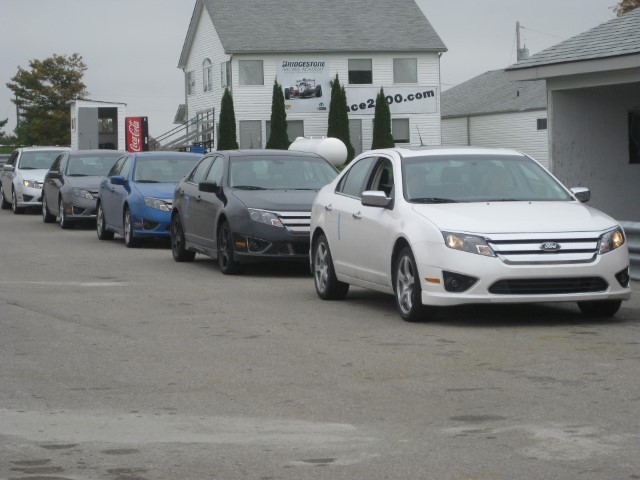
BOWMANVILLE, ON: “I can’t tell the difference… can you tell the difference?” Other than this being a pop culture reference from a decade or two ago in the comparison of a value-priced shampoo and the (at the time) number one selling brand, blind tests have been a tried and tested form of instant affirmation of a brand’s status – regardless of the product.
And so it was one morning in early fall as the leaves were beginning to turn that a small group of automotive journalists made their way to Mosport, now more correctly referred to as Canadian Tire Motorsports Park or CTMP near Bowmanville, Ontario.
We were here to test a Sailun Tire against a very popular competitor in the Canadian marketplace.
Initially assembled in the now demolished Castrol control tower, we sat and listened, made notes as we were told the story of Sailun Tires, their origins and future plans – specifically in Canada.
To many of you reading this, Sailun is a typo, a name not currently in your lexicon – automotive or otherwise. And for the most part, that was pretty close to the mark for the assembled auto writers in the room. In fact, employees and technicians of Sailun painfully outnumbered writers.
Some had heard of the brand before, but no-one had any direct experience. Or had ever knowingly driven any vehicle clad with Sailun rubber before. There was a palpable nervous chuckle and anxious glances at this fact from Sailun employees over this reveal.
But let’s address the back story before we go any further. Sailun Tires are a division of a bigger organization; Dynamic Tire Corp. Sailun Tires are made in China. OK, there we go; the 800 pound gorilla in the room. The tires are made in China! But wait, there are more than 600 tire manufacturing facilities in China including some ‘household’ names, such as Goodyear, Michelin, Pirelli and Bridgestone, to name a few.
That tidbit certainly got the attention of the assembled writers and the room was silent: Brian Mielko, Vice President Marketing certainly had our attention.
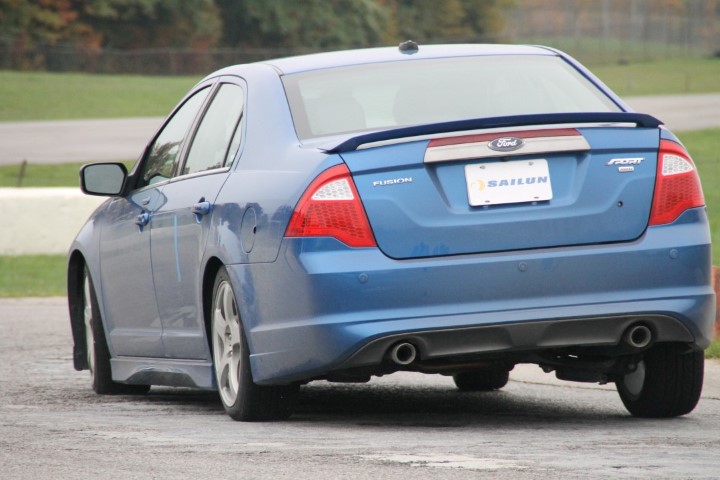 First and foremost, Sailun recognizes that it is not an industry leader. They are quite comfortable in the value tier segment of the tire world. Some of the facts that got knowing nods at appropriate moments included 41% of aftermarket tires are sold from the value tier segment; the value tier market comprises some 24%.Within this market there are dozens of choices.
First and foremost, Sailun recognizes that it is not an industry leader. They are quite comfortable in the value tier segment of the tire world. Some of the facts that got knowing nods at appropriate moments included 41% of aftermarket tires are sold from the value tier segment; the value tier market comprises some 24%.Within this market there are dozens of choices.
Is there one that is any better than the other?
To be clear, Mielko and his team were not here to take on the world of tires. They were here to attempt to demonstrate that there is another viable alternative in the crowded value tier tire landscape. However, because their brand is not first on the lips of drivers and dealers and not being in the top five, by sales volume in any market does not mean that they cannot produce a great tire. Sailun’s goal today and every day after this is not to prove their tires are the best. They want an opportunity to demonstrate that their brand is as good as anyone else’s. Not a lofty goal, perhaps, but the proof would be there for all to see shortly.
We were now ready to head out to the Driver Development Track (DDT) of CTMP to play with the tires and of course, cars. Before leaving it was suggested that there would be a reveal of the competitor’s brand at lunch time, half way through our testing. To a person this notion was, to the obvious pleasure of Sailun execs tossed out. This was to be a true blind test all the way through. No reveal until the last brake pad and rotor had a chance to cool down.
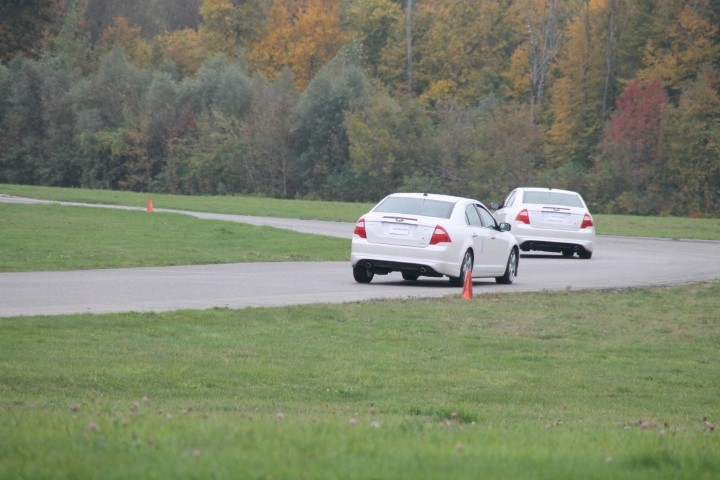 All of the tires we would test drive had the names and identifications buffed off the tire’s sidewalls. So, unless you were an expert on tread pattern there was no way of knowing which tires were fitted to the car. Our cars for the day were Ford Fusions and needless to say, everyday driver’s are not encouraged to do what we did to the cars and especially the tires over those the next few hours. Do not try this at home.
All of the tires we would test drive had the names and identifications buffed off the tire’s sidewalls. So, unless you were an expert on tread pattern there was no way of knowing which tires were fitted to the car. Our cars for the day were Ford Fusions and needless to say, everyday driver’s are not encouraged to do what we did to the cars and especially the tires over those the next few hours. Do not try this at home.
The first test consisted of drives around the DDT in the opposite direction to the way it was designed. We were requested to travel at a maximum of 80 km/h to simulate driving on rural two-lane highways. Cars were marked clearly either “1” or “2”. On this test the tires on “1” produced minimal road noise and did not squeal under moderate cornering loads while offering good levels of grip in generally accepted non-aggressive driving conditions. The “1” tires were almost predictable – a good thing, especially as they seemed to subliminally grip through all corners – in my opinion. Generally, the tires on “2” car did not feel the same – less comfortable over all yet perhaps providing a marginally better steering response.
After each lap in every car, eager techs descended upon us with tablets looking for us to offer immediate opinions on predetermined test templates while the ride was fresh in our minds. This would occur each time any driver stepped from a Ford Fusion. A little annoying but definitely necessary.
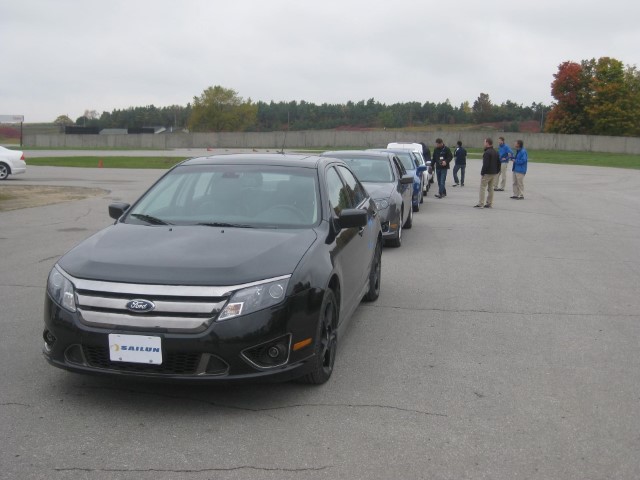 Next we were taken to the wet slalom, where we performed the autocross course at speeds of 50 km/h, 60 km/h, and then as fast as we could. The cars were still “1” or “2” – some were FWD, some AWD but regardless, we drove all configurations equally.
Next we were taken to the wet slalom, where we performed the autocross course at speeds of 50 km/h, 60 km/h, and then as fast as we could. The cars were still “1” or “2” – some were FWD, some AWD but regardless, we drove all configurations equally.
Again every vehicle and their buffed rubber seemed very close in performance – this was, indeed, the Pepsi challenge revisited.
After lunch it was hot laps on the DDT – going the right way around the course that many of us had experienced before – in fact, my first turn around this track was on a Bridgestone-sponsored event. Long story short, in spite of every driver’s best efforts, no cars ploughed the in-field and no tires were blown. It appeared that none of us could really tell the two seemingly different sets of tires apart.
To Brian Mielko and his team, this was an automotive dream.
Over coffee in the old Castrol tower, we waited patiently as the survey results were carefully tabulated. It was then revealed that tire “1” had been the Sailun Z4+AS and that tire “2” had been the Continental Extreme Contact. As stated, anecdotally we all thought that overall there were no discernible differences between the popular Conti rubber and the Sailun contender.
Then came the actual results.
On the wet slalom, tires were rated on four criteria: overall control and predictability; cornering stability; steering feel; and, traction under acceleration. Sailun performed marginally better in all categories.
Next was the road drive with one added category – drive comfort. Sailun prevailed again.
Then we had tracking. Five categories similar to the slalom with the addition of confidence on braking. Sailun bested Conti in four of five categories, being narrowly edged out on steering feel and responsiveness.
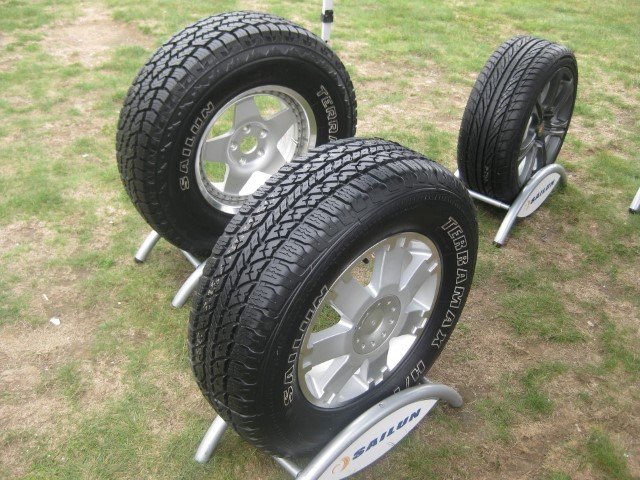 So at the end of the day with a possible score of 40, Continental came in at 30; Sailun edged them with 31.
So at the end of the day with a possible score of 40, Continental came in at 30; Sailun edged them with 31.
Then a marketing manager shared additional information: a couple of phone calls moments before to tire dealers in the Toronto area revealed that the Sailun Z4+AS retailed at $111 per tire and the Continental for $189. That is a huge 70% price difference!
Smiles all round; mission accomplished – at least as far as the day was concerned. Tires as good as a major competitor – and way less expensive.
Can Sailun succeed in their quest to be seen as an industry leader in the value tier segment? They are making all the right moves at the back end with expansive new warehouse facilities in Brampton and with major quality control measures for every tire that comes off the production line – yes, you read that correctly; each and every tire is tested before it heads out to any market for resale. Time, of course will tell. They are taking their future very seriously and carefully. They’re not looking for global domination, merely some respect and the ability to sell more tires – especially in the challenging Canadian market.
As we left the parking lot we could see high fives and broad smiles being exchanged.
My thoughts? I wish them every success. On the day, their tire performed well. It stood up against a brand leader. And bested it by 70% on price. I’d buy them and give them a chance. As a true Canadian my response is not “Why?” but a resounding “Why not!”

